Positive Health Online
Your Country

Pets as Therapy: The Ultimate Guide
listed in animals, originally published in issue 246 - May 2018
Reproduced from Wild Science/ Pets as Therapy: The Ultimate Guide
Animals have been bringing smiles to our faces for years, but that’s just scratching the surface of what they’re capable of. Animal-assisted therapy (often shortened to AAT) has solidified itself as a genuine form of therapy and has improved the lives of thousands of people all over the world. While therapy dogs are particularly popular, all sorts of animals, from rabbits to snakes, are used. The stats support it, the patients love it, and if you want to know more, you’re in the right place. This is the ultimate guide for everything you need to know about AAT and using pets as therapy.
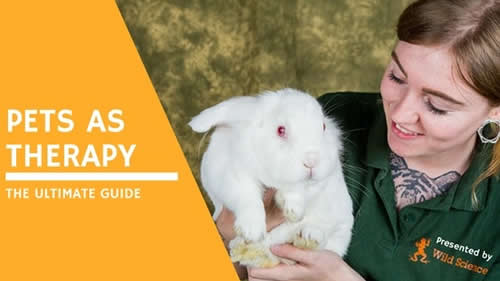
Animal-assisted Therapy – What is It?
A definition of animal-assisted therapy can be found in the work of Hines & Bustad (1986). They wrote that using pets as therapy is based on the concept that an animal interacting with a human can result in psychological changes and physiological benefits. This is particularly true when a specific goal is identified that the benefits of animal interaction (see below) can help achieve. That strong human bond with animals has roots in societies thousands of years old, and according to research held by Jennifer Jorgenson (1997), domestication of animals began as far as 12,000 years ago. The earliest recording of an animal being used as therapy, however, was in 1860. Florence Nightingale (1969) was one of the first people to seriously consider the medical impact an animal could have on a person. In an effort to cut down York Retreat’s reliance on drugs, the hospital decided to try small domesticated animals to provide relief for their patients as an alternative.
After the success of this, the practice eventually grew momentum and reached America. As early as 1944, hospital patients in Pawling, New York were urged to work on a local farm as a form of treatment. This is considered ‘pet visitation’ and is regarded as the simplest form of animal assisted therapy, however that should not undermine the effectiveness of it.
Forms of animal therapy can now be seen everywhere in today’s society, from class rooms to nursing homes, due to the wide variety of benefits it can provide.
Animals and you - who can AAT help?
You might not have realized it, but it’s highly likely that you’ve already experienced some of the benefits of animal-assisted therapy. If an amusing video of a hamster has made you laugh, or a certain dog in the street made you smile, then that will give you an idea - even on such a small scale - of the effect that animals can have on humans.
Below are a select few groups of people that benefit from AAT, which we’ve singled out in particular as they have considerable results and scientific evidence supporting the effects on the group
How AAT Helps the Elderly
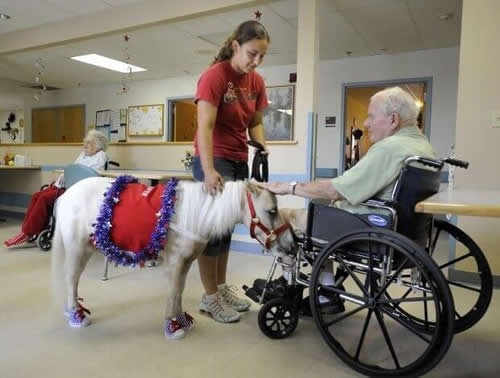
For residents who are less mobile and struggle to move around, animal therapy is a great way to provide a unique and new experience for them. The impact of the animals has a mental effect beyond this, however. A recent study (Cherniack, E & Cherniack, A, 2014) ran a series of experiments and reported this in their paper which can be found here:
“One trial uniquely noted that animals conferred psychological benefits to cognitively unimpaired older individuals; 144 persons without cognitive impairment in nursing homes in Italy were exposed to either a canary, a plant, or neither of the two. The individuals assigned to care for a canary or plant were provided with care instructions and participated in a three-month intervention, the details of which were not specified in the paper. Subjects who cared for the bird had significantly better (behavioural symptom) scores at the end of the intervention on subscales of psychological symptoms in the Brief Symptom Inventory and LEIPAD-II-Short Version, which subjects in the other two groups did not.”
Some of the other benefits of animal therapy with the elderly include:
- Improved motor skills and joint movement;
- Reduced feelings of depression;
- Improved self-esteem;
- Reduced loneliness;
- Improved verbal communication;
- Reduced levels of boredom;
- Improved social engagement capabilities;
- Reduced levels of anxiety.
How AAT helps people with PTSD
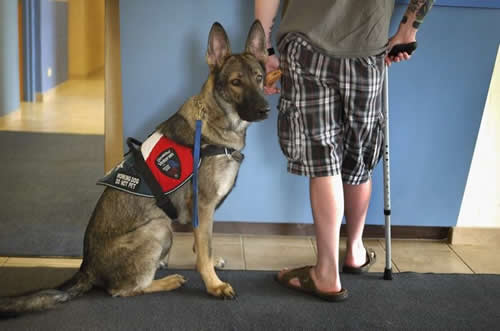
Short for ‘post-traumatic stress disorder’, PTSD is a severe mental health problem that is associated with witnessing a particularly harrowing event. It is often associated with combat and veterans, but not restricted to those. While medication and group counselling are an important part of the recovery process, animal therapy provides different types of assistance. For example, a psychiatric service dog can help perform tasks that the owners may not be able to accomplish themselves, and there are several cases of them helping an individual with PTSD return home if they wander away during a flashback or episode.
O’Haire et al (2015) wrote this paper researching the effects of animal-assisted intervention on Post-Traumatic Stress Disorder, and drew the following conclusion:
“Preliminary findings are encouraging and suggest that participating in Animal-Assisted Intervention can provide at least short term, positive outcomes related to reduced PTSD symptoms, depression, and anxiety. Further, in-depth investigation of Animal-Assisted Intervention for trauma will enable a better understanding of how, when, and for whom it is beneficial.”
Animal therapy is particularly popular among people with PTSD as a lot of the symptoms of the disorder can be countered by the effects of animal-assisted therapy. A few of the relevant benefits include:
- Reduces feelings of depression;
- Creates motivation for faster recovery;
- Reduces loneliness;
- Maintains/increases exercise levels;
- Reduces levels of anxiety;
- Encourages communication.
How AAT helps People with Autism
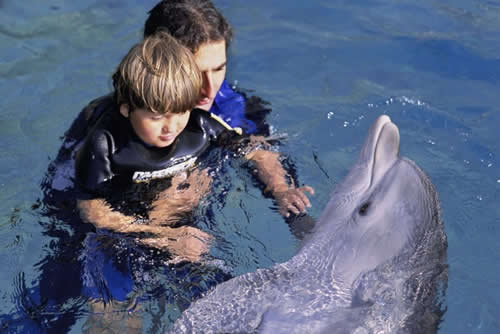
The main effects of having autism spectrum disorder (sometimes referred to as ASD, or simply autism) are generally based around difficulties with communicating and socialising. Since one of the most beneficial qualities of animal-assisted therapy is how it can improve a person’s social skills, it makes sense that using pets as therapy has become so popular for those diagnosed.
Therapy dogs are frequently paired up with the people with autism, often helped by various health and pet charities, but there are many other animals that can help. Sara Gee is a riding instructor at The Donkey Sanctuary, a charity which is trying to transform the lives of donkeys and mules by nurturing their relationships with people. As a firm believer in using donkeys as therapy, Sara had to the following to say:
- “For autistic children, we find the benefits are many. Initially, the experience of stroking our donkeys can be fraught, patience whilst waiting for a ride is needed. (…) The simple aim of the therapy is to teach children to sit quietly and kindly on their donkey and enjoy the ride whilst taking part in exercises that encourage listening and following, colour recognition, counting and making choices.”
- A recent study titled “Effects of Classroom Animal-Assisted Activities on Social Functioning in Children with Autism Spectrum Disorder” (O’Haire et al, 2015) examined the effect guinea pigs had on children with autism. The following is a quote from the research paper:
- “Significant improvements were identified in social functioning, including increases in social approach behaviors and social skills, and decreases in social withdrawal behaviours, from before to after the AAA (Animal-Assisted Activities) program.”
How AAT helps School Children
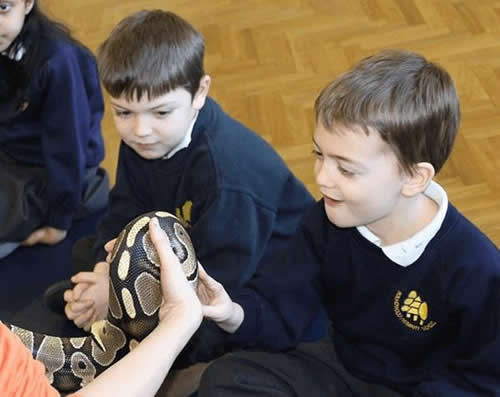
The focus for animal-assisted sessions with school children are generally not as focused on the same kind of therapeutic benefits as the other examples in this section. However, animal interaction has been proven to have considerable educational benefits for young people in particular. Integration with the school curriculum also means they can provide a hyper-relevant form of education; reading a biology book about animals pales in comparison to the actual experience of holding one. For children that struggle to learn, this kind of hands-on assistance can be vital.
Animal workshops can visit schools (a service we provide) and are more than equipped to discuss the following topics with students for an enhanced educational effect:
- Food chains;
- Nutrition;
- Life cycles;
- Genetics;
- Evolution;
- Habitats;
- Living organisms.
Paws For Thought - What Animals are the Most Effective?
The question of the “most effective” therapy animal is difficult to answer, but it’s a question we get a lot, so we’ll address it regardless.
Since so many people have different tastes, the answer is an ever-changing one. Studies show cats help with depression, but they won’t be as effective if the person already does not like cats. If someone loves ducks, then even though there might be less research to support that animal in particular, they might find ducks far more effective than anything else.
Even then, in an abstract sense of the word, people with a phobia of snakes may find holding a snake therapeutic in hindsight as it could help them overcome their fear. This transition from fear or anxiety to a more relaxed state is the root of therapy.
Well-educated staff will always be there to assess the person and situation and provide what they think the best animal is for that case in particular and it might not always be something cute and fluffy. There might not be an ‘ultimate therapy pet’, but there is definitely criteria that you’d ideally want your animal to meet. Opinion and taste change depending on who you ask, but these are important factors regardless of the breed of pet:
- The animal is comfortable with the assigned person, especially for long periods.
- The animal is comfortable being touched by the person. Physical touch is an important factor in nurturing relationships, and is very important to the therapy process.
- There should be a back-up plan for if it does not work out with the animal. You should either still be able to look after it, or be able to fairly easily find an adopter/rescue shelter for it.
- The animal suits the humans specific needs. For example:
- If the person is easily scared or very anxious, a quiet animal may be the best choice;
- If the person is withdrawn, an active and affectionate animal may be the best choice;
- If the person needs attention, then an animal like a dog that follows instructions or a bird that can speak may be the best choice.
Frequently asked questions about using pets as therapy
We often get asked a lot of the same questions, so we thought it would be best to address them here and save you the effort of going elsewhere! Remember, you can also contact us directly with any questions you have about animal therapy or animal workshops and we’d be more than happy to help you.
“How does animal assisted therapy compare to something like music therapy?”
For those unfamiliar with it, music therapy is the delivery of music-based experiences by a board-certified music therapist, with a clear patient/therapist relationship. One similarity between the two forms of therapy is that the directions need to be followed closely for maximum effect. Instructions can’t be used as a ‘rough guide’; you can’t just listen to any music by yourself to replicate the effects of music therapy, and you can’t just look at any animal to replicate the effects of animal therapy. It also has similar benefits to animal and pet therapy, in that they both help combat things such as anxiety and depression and improve elements such as communication and self-confidence.
However, due to the fact that you need to have an appointment with a music therapist to get the most out of that form of therapy, it might be more difficult for some to use; as opposed to animal therapy where in a lot of cases, the animal is always with the person it is assigned to.
Animals can also provide more utility than a lot of other types of therapy. For example, the excellent team at Monkey Helpers teach monkeys to help their carers by performing tasks for them that they may not be able to do otherwise. From flipping a page in a book, to pressing a buzzer for assistance, you can find out more about helper Capuchin monkeys below:
“Can dogs help with anxiety even if they haven’t been trained?”
A dog, or any animal for that matter, that’s trained specifically for therapeutic purposes will almost always be a better option than just a random animal picked up off the street. However, there are plenty of animals that get little to no training at all and still produce impressive results. Again, the individual is so important to this process. Dogs for anxiety and depression have been proven to be very effective, and if it’s a dog you grew up with for years than this could be to an even better effect than one that is trained and introduced half way through both the animals and the humans life.
Some animals, like lizards or tortoises, just don’t have the brain capacity to physically learn things; but that doesn’t mean that someone can’t use that bond to overcome things like anxiety and social difficulties. Pets for homes and with no training can still be used for therapy.
“Why do humans like petting animals so much?”
Petting hairy or furry skin is actually a pleasure sensation that’s hardwired into us. Stroking a hairy animal, such as a cat or dog, releases a chemical called oxytocin in both parties.
For humans, this has been proven to improve social bonds and happiness levels, as well as reduce pressure and stress. For the animals, this also appeals to the master/servant complex; if an animal is getting stroked, then they feel reinforced that they’ve been well behaved, and feel happier.
Conclusion
It is hard to argue with the facts and figures: animal-assisted therapy helps people.
We hope that this piece has helped open your eyes to what animals are truly capable of, and how they can help us overcome our personal problems. If you think you, or someone you know, could benefit from using pets as therapy, then we can’t encourage you enough to seek out that help. Whether your Grandmother needs cheering up because she’s feeling lonely at her nursing home, or your child has problems communicating with others, or any other of the multitude of problems that animal therapy helps with; we and many others firmly believe that it could be the answer. There aren’t many other types of therapy that involve playing with cute animals, either.
Further Teading/ References
Jorgenson, J. Therapeutic use of companion animals in health care. Image: Journal of Nursing Scholarship, 29(3), 249-254. 1997.
Carmack, B. J., & Fila, D. Animal-assisted therapy: A nursing intervention. Nursing Management, 20(5), 96-101. 1989.
Nightingale, F. Notes on Nursing. p. 103. New York: Dover Publications. (Original work published 1860). 1969.
Hines, L., & Bustad, L. Historical perspectives on human animal interaction. Phi Kappa Phi Journal, 4-9. Spring 1986.
Cherniack, E & Cherniack, A. The Benefits of Pets and Animal-Assisted Therapy to the Health of Older Individuals, Hindawi, Volume 2014.
Cherniack, E & Cherniack, A. The Effect of Using Pets as Therapy. Hindawi, Volume 2012.
Crane, L. Animals, Horseback Riding, and Implications for Rehabilitation Therapy. The Journal of Rehabilitation. 1999.
O’Haire, M. Animal-Assisted Intrervention for Trauma, Including Post-Traumatic Stress Disorder. HABRI Central Brief. 2015.
www.raisingtroubledkids.com/animals-that-make-good-therapy-pets
https://www.youtube.com/watch?v=gn6E9GAe-7s
Reproduced from Wild Science/ Pets as Therapy: The Ultimate Guide
Comments:
-
No Article Comments available